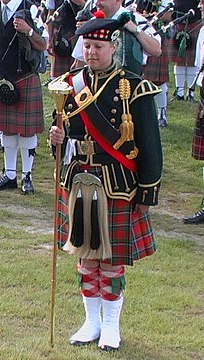Sporran
A sporran ( Scottish for "wallet") is part of the traditional clothing of the inhabitants of the Scottish Highlands . He replaces the pocket of the otherwise pocketless kilt .
General
A sporran is made of leather or fur and is decorated with different decorative elements. It is worn on a chain or hung from a belt, usually in front of the wearer's groin. Since the traditional kilt has no pockets, the sporran serves as a purse or container for other personal items. It goes back to belt bags that were common in the Middle Ages .
The sporran hangs directly under the belt buckle, paying great attention to the consistency of style and design. The belt buckle can be very elaborately decorated; it often contains the same motifs as the Sporran or the Sgian Dubh worn in a stocking . The Sporran can also be pushed sideways on the hip when in use.
Variants of the sporran
"Everyday spurs" are usually simple brown or black leather bags with little jewelry. These are usually three leather tassels and sometimes simple decorations such as Celtic knots .
"Fixed spurs" are larger and more ornate than "everyday spurs". Victorian examples are often very elaborate and stand out from the simple leather bags of the 17th or 18th century. Similar to the Bavarian Charivari , various decorative elements are attached. These include semi-precious stones, jewels or typical Scottish motifs such as Celtic knots , coats of arms and badges of the national saint St. Andrew , medals , clan coats of arms or Masonic motifs . A fur-covered face with fur or hair tassels is often depicted on the “fixed spurs”.
"Horse hair porrane" belong to regimental uniforms. Piper often wear very conspicuous sporranos with long horse hair that dangle back and forth with every movement.
Regimental spur of a female drum major at the 2004 Highland Games
Fur sporran with a stylized hump shield as a push button, Highland Games 2005
Sporran on a historical actor's belted plaid in 2006
Manufacturing
Sporran are mainly made of fur and leather.
In 2007, the BBC reported in a report that a law introduced by the new Scottish regional government was forcing Sporran owners to obtain a license. However, the law only affects foreign trade. In any case, skins of protected species (such as otter skin ) were rarely used for the sporran.
Web links
- X Marks the Scot - Kilt Wearer International (English)
- The special sporran the Super Bowl (English)
- The Brotherhood of the Kilt - Global Community to promote kilts (English)
Individual evidence
- ↑ Clothing instructions (PDF; 108 kB) Retrieved on February 15, 2011.
- ↑ Sporrant carriers may need a license (English) . Retrieved June 25, 2007.



